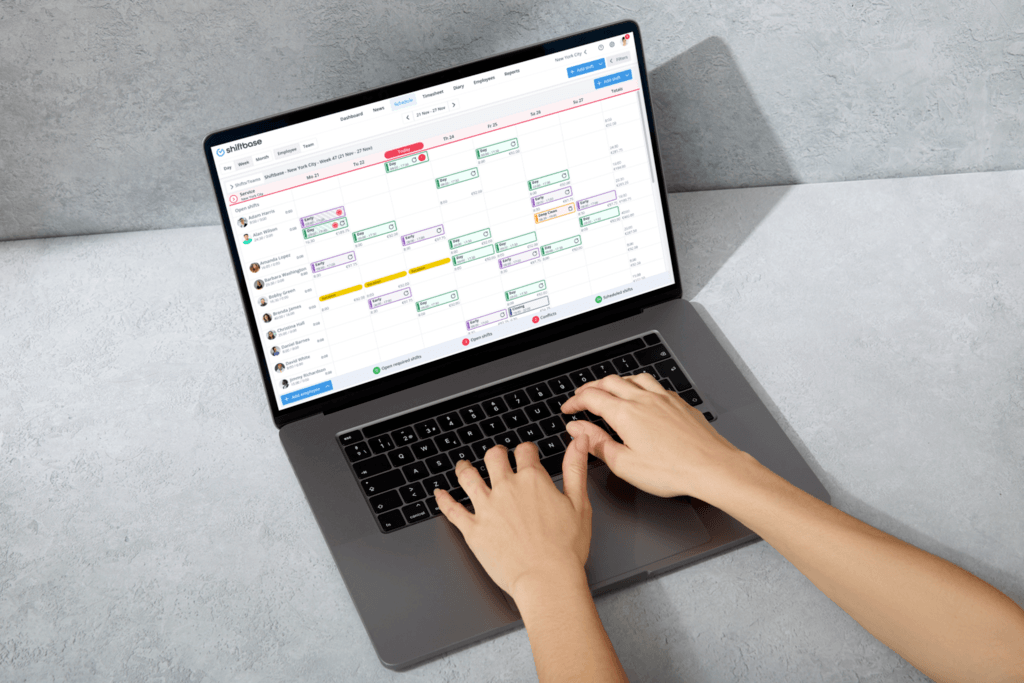In this article, we’ll help managers and employers understand what a staffing plan is, why it’s essential, and how to implement one efficiently.
What is a staffing plan?
A staffing plan is a roadmap designed by HR professionals to help businesses anticipate their future staffing needs and manage their workforce accordingly. It involves assessing current employees, identifying gaps in skills, and analyzing both internal and external factors that could impact staffing.
This strategic approach ensures that the company has a sufficient number of staff with the right skills to meet ongoing and future business objectives. The plan not only considers how many employees are needed but also focuses on other aspects like succession planning, skill development, and aligning human resources efforts with overall business growth.
It acts as a blueprint that guides the HR department through recruitment, training, and retention strategies, helping to predict future demand and manage labor costs effectively.
Why your business needs a staffing plan?
Having a staffing plan is more than just an administrative act; it’s a strategic component of human resource management. Here’s why every business should have one:
Align staffing with business goals:
A staffing plan aligns your human resources with your business goals. By using historical data and forecasting methods, HR professionals can predict future demand for skills and prepare accordingly. This alignment helps ensure that your business has the workforce needed to support future growth and objectives.
Anticipate and fill skills gaps:
Through skills gap analysis, a staffing plan helps you identify gaps between the skills your current employees have and the skills your business will need. This proactive approach allows for targeted training and recruiting, ensuring your team is well-equipped to handle upcoming challenges.
Control labor costs:
Effective staffing planning helps you optimize your workforce. By understanding your staffing needs, you can avoid understaffing, which can lead to overtime costs, or overstaffing, which can inflate your payroll unnecessarily. Strategic staffing helps maintain balance and reduces financial waste.
Manage business and HR risks:
A staffing plan takes into account various business factors and internal and external influences that can affect your staffing needs. This foresight helps mitigate risks associated with sudden changes in the market or industry, ensuring your business remains resilient and adaptive.
Support succession planning:
Staffing plans are integral to succession planning. They ensure that you have a pipeline of talent ready to fill key positions as they become vacant, either through unexpected departures or planned retirements. This planning is crucial for maintaining continuity and stability within your company.
What are the steps to creating a staffing plan?
Creating an effective staffing plan is crucial for aligning your workforce with your business strategy and future needs. This detailed guide walks you through each step, ensuring your staffing efforts support your company's objectives and help you manage your human resources efficiently. Let's delve into these essential steps.
Step 1: Assess your current workforce
The first step in creating a staffing plan is to conduct a thorough assessment of your existing staff. This involves analyzing the skills and performance of your current employees to identify any gaps between their capabilities and the business's needs. Workforce analytics plays a pivotal role in this process, providing data-driven insights that help you understand your current staffing landscape.
How to assess your current workforce?
-
Conduct performance reviews: Regularly evaluate the performance of each employee to measure their contributions and effectiveness.
-
Skills inventory: Create a comprehensive list of skills each employee possesses and compare it with what is needed for future projects or roles.
-
Employee surveys: Gather feedback directly from employees about their job satisfaction and aspirations, which can highlight potential areas for development.
-
Utilize workforce analytics tools: Implement tools that can analyze employee data to help forecast needs and identify trends in employee development and retention.
-
Gap analysis: Perform a skills gap analysis to pinpoint the specific skills and roles your business lacks, which are critical for future growth.
Step 2: Define business goals and objectives
Aligning your staffing needs with your business goals is essential for strategic business planning. This step ensures that every hiring or development effort contributes directly to the company's long-term success.
Examples of setting clear and measurable goals that affect staffing:
-
Increase sales revenue by 20% over the next year: This might require hiring more sales staff or developing current staff to enhance sales skills.
-
Improve product development cycles: Staff up the product design team by hiring additional skilled engineers and designers.
-
Enhance customer service: Train current employees or hire new staff to meet enhanced customer service goals, aiming to increase customer satisfaction scores by 15%.
Step 3: Forecast future staffing needs
Forecasting future staffing needs is critical to preparing for growth and changes within your market. This step involves using both quantitative and qualitative methods to predict future staffing demands based on industry trends, business growth, and technological advancements.
Effective forecasting helps you anticipate changes in the demand for labor, allowing you to respond proactively rather than reactively. It ensures that you have the right number of employees with the necessary skills at the right time.
Useful Read: How Skills-Based Hiring is Redefining Recruitment
Techniques for forecasting staffing needs:
-
Trend analysis: Look at past staffing trends in your company and industry to predict future needs.
-
Ratio analysis: Use ratios such as staff-to-sales or staff-to-production volume to determine optimal staffing levels based on changes in business volume.
-
Use forecasting software: Implement advanced forecasting tools that can analyze current data and predict future trends in staffing.
-
Scenario planning: Consider different future business scenarios and how they might impact your staffing needs, such as a tight labor market or rapid technological change.
-
Consult with leadership teams: Regular meetings with your company’s leadership to align the staffing plan with evolving business strategies and external factors.
Step 4: Create job descriptions and roles
When you clearly define job roles, you make sure your team covers all the bases your business needs to thrive. Think of job descriptions as tools not just for hiring, but also for managing your team's performance. They set clear expectations for what's required in each role and help measure how well these are being met.
Steps to write effective job descriptions that attract the right talent:
-
Start with a clear job title: Use a title that reflects the role's duties and is recognizable in your industry.
-
Outline the job's purpose: Briefly describe how the role contributes to the company's goals.
-
List specific responsibilities: Be detailed about what the job entails to avoid any confusion and to attract candidates who are ready for these tasks.
-
Include required skills and qualifications: Specify the education, experience, and technical skills needed. Mention soft skills that are crucial for the role.
-
Describe the working conditions: Include work hours, travel requirements, and any physical demands.
-
Add information about salary and benefits: Be transparent about the compensation range and benefits to attract the right candidates.
Step 5: Sourcing and recruiting talent
Finding the right people involves more than just posting a job ad. You need to use a mix of strategies to reach the best candidates.
Recruitment strategies:
-
Digital platforms: Use job boards, social media, and company websites to post job openings.
-
Recruitment agencies: These can help find candidates with specific skills or in tight labor markets.
-
Networking: Attend industry events or use professional networks like LinkedIn to connect with potential candidates.
Best practices for an efficient and inclusive hiring process:
-
Streamline the application process: Make it easy to apply and communicate clearly and frequently with candidates.
-
Use structured interviews: This keeps the assessment consistent and fair for all candidates.
-
Focus on diversity: Aim for a diverse workforce that can bring a variety of perspectives and skills to your company.
Evaluating candidates - what to look for beyond the resume?
-
Cultural fit: Ensure their values and work style align with your company's culture.
-
Potential for growth: Look for candidates who can evolve with your company and take on new challenges.
-
Soft skills: Communication, teamwork, and problem-solving skills can be just as important as technical abilities.
Step 6: Selecting and hiring process
Choosing the right candidate is key, and it starts with a good selection process. First, screen the applications to find matches based on the job requirements. Then, conduct interviews to dive deeper into candidates' experiences and skills, and assess their fit with your company culture.
Don’t forget to include practical assessments if the job demands specific technical skills. It’s also crucial to stay on top of legal requirements, like making sure all candidates can legally work in your area and adhering to fair employment practices.
Once you’ve picked the right candidate, make their transition into your team as smooth as possible. An effective onboarding program, a mentor for guidance, and regular employee feedback can help new hires integrate successfully and quickly become part of the team.
What is a staffing management system?

A staffing management system is a software tool designed to streamline all aspects of managing a company's workforce. It helps organizations plan, recruit, deploy, and track employees efficiently. This type of system integrates various HR functions, including recruitment, staffing planning, employee scheduling, and performance management, into one unified platform.
Useful Reads:
Employee Management Software for small business - A Guide
The 6 top Employee Performance Management Trends of 2024
By automating many of the manual processes associated with human resource management, a staffing management system can significantly reduce the time and effort required to manage staffing needs.
Benefits of using a staffing management system:
-
Improved Efficiency and Time Savings: Automating staffing tasks like scheduling, payroll, and compliance reporting saves time and reduces errors. This allows HR staff to focus on more strategic tasks rather than administrative duties.
-
Enhanced Data Analysis and Decision Making: With integrated data analytics tools, staffing management systems provide insights into workforce trends, helping businesses make informed decisions about hiring, training, and employee development.
-
Better Compliance and Risk Management: These systems help ensure that staffing practices adhere to legal and regulatory requirements, reducing the risk of non-compliance penalties. They can automatically update to reflect changes in employment laws, helping companies stay compliant.

Your work schedule in one central place!
Conclusion
Building an effective staffing plan is more than a routine HR task—it's a strategic imperative that aligns your workforce with your business goals.
From assessing your current workforce to forecasting future needs and effectively recruiting and integrating new talent, each step is crucial in developing a staffing strategy that not only meets your immediate needs but also positions your business for long-term success.
By incorporating a staffing management system, you can further enhance the efficiency and effectiveness of your human resources efforts. Armed with this step-by-step guide, you're now ready to create a staffing plan that ensures your team is robust, capable, and ready to drive your business forward.
Optimize your staffing plan with Shiftbase
Efficient staffing is crucial for any organization's success, and Shiftbase provides the tools you need to create and implement an effective staffing plan. Our employee scheduling feature allows you to strategically align your workforce with business demands, ensuring you have the right people at the right time.
Additionally, our time tracking capabilities provide insights into employee hours, aiding in workload management. Absence management ensures that leave does not disrupt business operations, maintaining continuity and productivity. Experience how Shiftbase can streamline your staffing process by signing up for a 14-day free trial here. Simplify your staffing plan with Shiftbase today.




